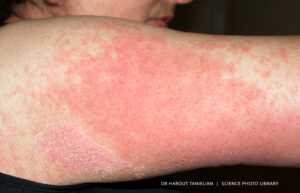Not all antibody-drug conjugates (ADCs) are the same regarding targets and payloads.
ADCs as a whole, however, are generally well tolerated but are associated with predictable adverse reactions that require diligent monitoring and timely management. The ADC sacituzumab govitecan has been associated with a median progression-free survival of approximately 6.4 months for patients with triple-negative breast cancer (TNBC) and 5.8 months for hormone receptor-positive (HR+)/human epidermal growth factor receptor 2-negative (HER2-) disease.1 Median overall survival has been shown to be 12.1 months2 and 14.4 months3, respective of disease type. Common and potentially serious adverse events associated with sacituzumab govitecan include high-grade neutropenia and diarrhea. In fact, recent NCCN Guidelines® updates have moved sacituzumab govitecan from the “low” to “intermediate” risk category for febrile neutropenia, with the NCCN defining intermediate risk as a 10% to 20% chance of developing the adverse event.4 Recent data, however, have shown that both incidence and severity of neutropenia may be improved using granulocyte colony stimulating factor (G-CSF) alone, and of diarrhea when G-CSF is combined with loperamide.1,5 Dr. Yara Abdou and nurse practitioner Erin Pierce discuss the uniqueness of sacituzumab govitecan among other ADCs and provide insights for best practices on management of neutropenia and diarrhea, as well as other related side effects.
Please explain how sacituzumab govitecan differs from other ADCs approved for the treatment of metastatic breast cancer.
Dr. Abdou: The U.S. Food and Drug Administration approval of sacituzumab govitecan in 2021 represented an important step forward in the treatment of metastatic breast cancer, particularly for patients with TNBC, a subtype known for its aggressiveness and poor prognosis. While other ADCs, such as trastuzumab emtansine (T-DM1) and trastuzumab deruxtecan (T-DXd), specifically target HER2, sacituzumab govitecan targets Trop-2, a transmembrane glycoprotein that is overexpressed in a wide range of cancers including breast cancer. Trop-2 expression is found in a large portion of breast cancers, making it a valuable target across a broad range of breast cancer subtypes.2 The broad expression of Trop-2 is one of the reasons sacituzumab govitecan is approved for metastatic breast cancer regardless of biomarker status. Unlike other HER2-targeted ADCs, which require HER2 testing for treatment selection, sacituzumab govitecan does not require Trop-2 testing. This makes it unique among ADCs, as it can be used in patients with metastatic TNBC and hormone receptor-positive (HR+)/human epidermal growth factor receptor 2-negative (HER2-) breast cancer without the need for companion diagnostic testing and regardless of HER2 status.
The other important difference in ADCs lies in their payloads and mechanism of action. Sacituzumab govitecan uses SN-38, the active metabolite of irinotecan, which is a potent topoisomerase I inhibitor. SN-38 induces DNA damage by inhibiting topoisomerase I, leading to DNA strand breaks and subsequent apoptosis in the targeted cells. Although SN-38 is highly effective at inducing tumor cell death, it is generally too toxic when used systemically. However, when conjugated to an antibody, it can be selectively delivered to cancer cells, minimizing the impact on healthy tissues.6–9 That said, sacituzumab govitecan can still cause systemic effects including neutropenia and diarrhea, which are common side effects associated with topoisomerase inhibitors. These side effects result from the cytotoxicity of SN-38 on both cancer and normal cells, particularly in tissues like the gastrointestinal tract and bone marrow.
Other ADCs such as T-DM1 and T-DXd use different payloads. T-DM1 uses emtansine, a microtubule inhibitor, while T-DXd uses deruxtecan, a topoisomerase I inhibitor. Both of these payloads also target cancer cells but can cause broader systemic toxicities due to their effects on normal cells. For example, the microtubule disruption seen with T-DM1 can lead to thrombocytopenia and hepatotoxicity, and DNA damage from T-DXd can lead to interstitial lung disease and other systemic toxicities.

Yara Abdou, MD, is an assistant professor at the University of North Carolina (UNC) and a breast cancer medical oncologist at the Lineberger Comprehensive Cancer Center. She leads the Breast Cancer Clinical Trials Program at UNC. Her research focuses on developing novel therapies and investigating biomarkers of disease recurrence and treatment response. Dr. Abdou’s research is also dedicated to addressing racial disparities in breast cancer outcomes and improving care for minority women. Her work has been recognized with awards from prestigious organizations, including the Breast Cancer Research Foundation, the American Society of Clinical Oncology, and the American Association for Cancer Research.

Erin Pierce, MSN, APRN, FNP-C, is a hematology/oncology nurse practitioner and associate clinical investigator with HonorHealth Research Institute. She serves as a principal investigator and sub-investigator on phase I and II studies.

By addressing common toxicities such as neutropenia and gastrointestinal symptoms early on, we can optimize treatment, reduce the risk of interruptions, and ultimately enhance therapeutic efficacy.
Dr. Yara Abdou
Prophylactic G-CSF has been shown to decrease incidence and severity of neutropenia when given alone and of diarrhea when given in combination with loperamide. Please comment on your thoughts about these findings.
Dr. Abdou: As an antibody-drug conjugate targeting Trop-2, sacituzumab govitecan has shown promising results in terms of overall survival in two phase 3 trials. However, neutropenia and diarrhea have been frequently observed, often leading to treatment modifications including dose reductions and interruptions. What stands out in the phase 2 PRIMED study is the incidence of neutropenia and diarrhea during the first two cycles of treatment. Among PRIMED participants, the incidence of any-grade neutropenia was 28%,10 which was significantly lower than the 63% seen in ASCENT2 and the 70% in TROPiCS-02.3 Similarly, the incidence of any-grade diarrhea in the first two cycles was 34%, compared to 59% in ASCENT and 57% in TROPiCS-02. The lower rates of neutropenia and diarrhea observed in the PRIMED study are encouraging, especially when considering the impact that these side effects can have on treatment adherence and patient quality of life. However, it is important to note that cross-trial comparisons are discouraged due to variations in trial designs, patient populations, and follow-up times.
The results of the PRIMED trial underscore the importance of incorporating supportive care to mitigate these side effects and improve treatment outcomes. The primary prophylactic use of G-CSF to reduce neutropenia and loperamide to manage diarrhea during the first two cycles resulted in a clinically meaningful reduction in the incidence of these AEs. This approach provides a practical strategy for minimizing treatment delays and enabling patients to stay on track with their sacituzumab govitecan regimen.
These findings emphasize the importance of a tailored and proactive approach to supportive care for patients receiving sacituzumab govitecan. By addressing common toxicities such as neutropenia and gastrointestinal symptoms early on, we can optimize treatment, reduce the risk of interruptions, and ultimately enhance therapeutic efficacy. Individualizing this supportive care based on each patient’s clinical needs, including overall health, comorbidities, and prior treatments, is essential. Ultimately, this personalized approach not only supports adherence to therapy but also preserves quality of life, allowing patients to continue treatment with fewer disruptions and sustained benefit.
Please define the high-risk population for whom prophylactic use of G-CSF is especially effective. Are there patients for whom you feel this approach would not be recommended?
Dr. Abdou: The high-risk population for whom prophylactic use of G-CSF is especially effective are elderly patients, who may have a diminished ability to recover from neutropenia due to age-related changes in bone marrow function. Patients with comorbidities, such as diabetes, cardiovascular disease, or renal impairment, are also at higher risk for neutropenia, as these conditions can compromise immune function and increase susceptibility to infection. Additionally, patients who have previously experienced chemotherapy-induced neutropenia are at increased risk for recurrence and would benefit from G-CSF to prevent severe neutropenia.
However, primary prophylaxis with G-CSF is not necessarily recommended for low-risk patients who do not have a history of chemotherapy-induced neutropenia and are otherwise healthy. For these patients, the benefits of prophylactic G-CSF may not outweigh the potential risks and costs, particularly given that their likelihood of developing severe neutropenia is lower. In these cases, G-CSF should be considered on a case-by-case basis.
Another consideration is the insurance coverage for primary prophylaxis with G-CSF. Although it has proven to be an effective strategy in preventing neutropenia for high-risk patients, insurance companies often do not cover primary prophylaxis for patients not meeting specific criteria, such as those without a prior history of neutropenia. This limitation can present a significant barrier to access, despite the clinical benefits. Care providers may need to navigate these insurance policies and potentially seek exceptions or justification based on the patient’s clinical situation.
How do you initiate shared decision-making conversations about potential adverse events with patients/caregivers when beginning sacituzumab govitecan?
Ms. Pierce: I begin the shared decision-making conversation by assessing the patient’s baseline knowledge and understanding how each patient prefers to receive education—whether it be through videos, printed materials, or just conversation. Everyone learns differently, and it’s important to respect that.
Because each patient’s physiology is different, it’s important to know your patient. I will sometimes order weekly labs for a patient who has been heavily pretreated, and I will have G-CSF already authorized and ready to give so that we can prevent more serious neutropenia.
Erin Pierce, nurse practitioner
Part of these conversations, of course, focuses on risk versus benefits, and this includes discussion of potential adverse reactions. I stress that all medications have potential adverse events, even those you can purchase over the counter at your local drugstore. I try to be transparent about all potential side effects because you don’t know which side effect a person will experience, and some of these side effects can be life-threatening in rare instances. Because of this, I really need to have open and honest communication with them about symptoms as soon as they begin to present. I use the example of a fire: it’s easier to put out a small fire that may have just started to slowly grow compared to a fire that’s been raging for days. Patients must understand the importance of proactive management, especially for certain side effects like neutropenia. Patients also must understand how their treatment history could play a role in incidence and severity of side effects, and so I talk about any prophylactic measures, such as use of G-CSF, which decreases their risk for febrile neutropenia. I also set expectations for frequency of labs because I will want new labs taken at every infusion to monitor their counts.
What are your recommendations for management of neutropenia and diarrhea when they do occur?
Ms. Pierce: Regarding neutropenia, it’s important to carefully review the patient’s history over the months prior to starting treatment. Some of these patients have already been heavily pretreated, and so they may already be starting with a low white blood cell count. Using this information, I tend to discuss with my collaborating physician whether we should start with a lower dose and work our way up, or whether we want to add G-CSF prophylaxis from the very beginning.
As mentioned earlier, I like to get labs at every infusion. If neutropenia is identified early (grade 1), I will treat and emphasize the need for monitoring. The patient should understand that, if symptoms begin between visits, an urgent care visit with additional labs is required. If the neutropenia is grade 3 or worse, we do hold therapy, administer G-CSF, and repeat labs in a week. What brand and formulation of G-CSF we are able to use depends on the patient’s insurance, as Dr. Abdou mentioned. If labs have improved at that time, I would reduce the sacituzumab govitecan dose by 25% and proceed with treatment. Once a dose reduction has been made, we do not re-escalate the dose.
Because each patient’s physiology is different, it’s important to know your patient. I will sometimes order weekly labs for a patient who has been heavily pretreated, and I will have G-CSF already authorized and ready to give so that we can prevent more serious neutropenia. Neutropenia should resolve within 3 days of administration of G-CSF. If I’ve given G-CSF and counts are not recovering even up to a week after administration, this would be a red flag for me. Unfortunately, I most likely will have to discontinue therapy.
Regarding diarrhea, I make sure that patients are aware that almost one-half of patients in a clinical trial for sacituzumab govitecan did experience diarrhea, but it was more severe—grade 3 or worse—for only approximately 4% of those patients.1 So diarrhea is a potential side effect, but it most likely will be extremely manageable. I tell patients to always have loperamide with them because, odds are that they will need it at 3 am and all of the stores will be closed. If patients have been prone to diarrhea in the past or if they have an anticholinergic reaction, they may need to be pretreated with atropine.
I would say I am comfortable if a patient has one loose stool a day. If loose stools are occurring more frequently, I will give loperamide upfront while ordering stool studies to check for issues like or Clostridium difficile parasites. If the stools are black and tarry, or if there is blood in the stool, this requires an in-person visit because this is a red flag. But once those stool studies are clear, diphenoxylate-atropine may be added. If a patient experiences grade 3 or 4 diarrhea, I typically just dose reduce the sacituzumab govitecan by one level at the next infusion.
What are your recommendations for management of other potential treatment-emergent adverse events that have been associated with sacituzumab govitecan, such as fatigue, nausea, and alopecia.
Ms. Pierce: Fatigue is probably the hardest to treat because most patients with cancer experience fatigue before they even begin treatment. Exercise is the only thing that we’ve ever seen in clinical studies to show benefit for cancer-associated fatigue. I tell patients that, although having some type of exercise plan is important, it doesn’t necessarily mean you need to go to the gym or for a 3-mile hike. It could take the form of a walk to the mailbox or around the block. Starting slow is fine. Additionally, having a regular sleep schedule with fixed wake times helps regulate circadian rhythms, leading to better sleep quality and less daytime fatigue.
Unfortunately, hair loss is a side effect for many patients. Although some patients are unconcerned about this as an adverse event, it is extremely upsetting for others. Make sure patients have resources regarding wigs or alternative head coverings. Also, some patients may find slow hair loss distressing, so shaving their heads may feel empowering in these situations. Hair loss associated with sacituzumab govitecan is usually temporary, and in my experience, hair should grow back after treatment cessation.
Similarly to how I approach diarrhea, being proactive with nausea and vomiting is going to result in the best-case scenario. Again assess whether the patient has had a history of nausea and vomiting with chemotherapy or, if they have been pregnant, during pregnancy. This information can provide an indication as to whether the patient is more predisposed to this adverse event. We want to make sure that we’re premedicating with dexamethasone and other antiemetics prior to initiating therapy, but we also want to be sure that the patient is working to prevent nausea and vomiting through appropriate dietary choices. Patients should be advised to stay away from greasy or fried foods, and dairy intake should be limited.
What are your best practice recommendations related to EMR use and documentation so that high-quality care is continuous, provider to provider?
Ms. Pierce: I cannot put enough emphasis on the value of having pre-built evidence-based clinical pathways within EMRs. This is a simple and effective way to ensure that all patients across the clinic receive the highest standard of care, consistently across providers. So, for instance, the standardized order sets that already include authorizations for atropine and other premedications in case of infusion-related reactions are pre-populated in our EMR. This allows the advanced practice provider to be more efficient with documentation and to focus a bit more on the patient during an exam versus on the paperwork. When the nurse sees the order, it’s immediately already signed and ready to be released, which streamlines workflow and efficiency. This is so important for providing the best care for our patients.
Another thing that could be included within an EMR would be a nursing checklist. I think nurses spend the most time with patients compared to the provider, whether it be the infusion nurse or the clinic nurse, and sometimes the patients will tell nurses different information than they will tell us as a provider. Patients may be scared that we’re going to discontinue their medication because of the potential side effects or they’re just so overwhelmed when they’re talking with us that they forget to mention something. So nursing checklists for high-risk conditions such as nausea, vomiting, and neutropenia, will help capture a more detailed assessment at every patient contact.
Last but certainly not least, incorporating real-time monitoring alerts into EMRs would be an incredible enhancement. For instance, if new lab results indicated that a patient was neutropenic, a prominent red flag or alert would immediately draw attention to it. Although this functionality may not be feasible yet in most systems, it would undoubtedly be a valuable addition to support the delivery of the highest-quality patient care.
References:
- Lopez E, Gión M, Ruiz-Borrego M, et al. Efficacy analysis & updated safety from the phase 2 PRIMED study of prophylactic granulocyte colony stimulating factor G CSF loperamide for patients pts with HER2 negative advanced breast cancer ABC treated w sacituzumab govitecan SG. Poster presented at: 2024 San Antonio Breast Cancer Symposium; December 11, 2024; San Antonio, TX. Session 1839.
- Bardia A, Hurvitz SA, Tolaney SM, et al. Sacituzumab govitecan in metastatic triple-negative breast cancer. N Engl J Med. 2021;384(16):1529-1541.
- Rugo HS, Bardia A, Marmé F, et al. Overall survival with sacituzumab govitecan in hormone receptor-positive and human epidermal growth factor receptor 2-negative metastatic breast cancer (TROPiCS-02): a randomised, open-label, multicentre, phase 3 trial. Lancet. 2023;402(10411):1423-1433.
- NCCN Guidelines® for Patients. Anemia and Neutropenia. © National Comprehensive Cancer Network, Inc. 2021. https://www.nccn.org/patients/guidelines/content/PDF/anemia-patient-guideline. Accessed January 17, 2025.
- Nanda R, Yam C, Spring L, et al. Management of Neutropenia and Effectiveness of Sacituzumab Govitecan in Patients With Metastatic Triple-Negative Breast Cancer Treated in Real-World Settings in the United States. Poster presented at: 2024 San Antonio Breast Cancer Symposium; December 11, 2024; San Antonio, TX. Session 1839.
- Goldenberg DM, Cardillo TM, Govindan SV, Rossi EA, Sharkey RM. Trop-2 is a novel target for solid cancer therapy with sacituzumab govitecan (IMMU-132), an antibody-drug conjugate (ADC). Oncotarget. 2015;6(26):22496-22512.
- Kopp A, Hofsess S, Cardillo TM, Govindan SV, Donnell J, Thurber GM. Antibody-drug conjugate sacituzumab govitecan drives efficient tissue penetration and rapid intracellular drug release. Mol Cancer Ther. 2023;22(1):102-111.
- Lopez S, Perrone E, Bellone S, et al. Preclinical activity of sacituzumab govitecan (IMMU-132) in uterine and ovarian carcinosarcomas. Oncotarget. 2020;11(5):560-570.
- Perrone E, Manara P, Lopez S, et al. Sacituzumab govitecan, an antibody-drug conjugate targeting trophoblast cell-surface antigen 2, shows cytotoxic activity against poorly differentiated endometrial adenocarcinomas in vitro and in vivo. Mol Oncol. 2020;14(3):645-656.
- García JMP, Gión M, Ruiz-Borrego M, et al. Prevention of sacituzumab govitecan (SG)-related neutropenia and diarrhea in patients (pts) with triple-negative or HR+/HER2- advanced breast cancer (ABC; PRIMED): A phase 2 trial. J Clin Oncol. 2024;42(16_suppl):1101.



